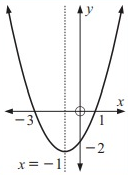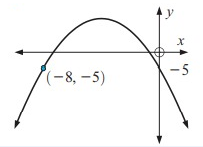FINDING EQUATION OF PARABOLA WITH X AND Y INTERCEPTS
Subscribe to our ▶️ YouTube channel 🔴 for the latest videos, updates, and tips.
To find equation of parabola with x and y-intercepts, we can use the following method.
y = a(x - p)(x - q)
Here p and q are x-intercepts and a is constant which is not equal to 0.
To find the value of a, we can apply the y-intercept. The sign of a will decide that the parabola opens up or opens down.
- If a > 0, the parabola opens up.
- If a < 0, the parabola opens down.
Equation of axis of symmetry :
The axis of symmetry lies halfway between the x-intercepts.
If p and q are x-intercepts, then equation of axis of symmetry is x = (p + q)/2
There are three possible situations for p and q.
 |
If p and q are different, the parabola will intersect x-axis at two different points. |
 |
If p and q are same, the parabola will intersect x-axis at once. |
 |
If p and q are not real, the parabola will not meet x-axis. |
Problem 1 :
Sketch the parabola which has x-intercepts -3 and 1, and y-intercept -2.
i) Find equation of parabola
ii) Find the equation of the axis of symmetry.
Solution:
x- Intercepts:
(-3, 0) (1, 0)
y- Intercept:
(0, -2)
Equation of parabola,
y = a (x - p) (x - q)
y = a (x + 3) (x - 1)
Substitute x = 0 and y = -2,
-2 = a (0 + 3) (0 - 1)
-2 = -3a
a = 2/3
y = 2/3 (x + 3) (x - 1)
The axis of symmetry lies halfway between the x-intercepts.
axis of symmetry = (-3 + 1)/2
= -2/2
= -1
So, axis of symmetry x = -1.

For each of the following:
i. Sketch the parabola
ii. Find the equation of the axis of symmetry.
Problem 2 :
x- intercepts 3 and -1, y- intercept -4
Solution:
x- Intercepts:
(3, 0) (-1, 0)
y- Intercept:
(0, -4)
Equation of parabola,
y = a (x - p) (x - q)
y = a (x - 3) (x + 1)
Substitute x = 0 and y = -4,
-4 = a (0 - 3) (0 + 1)
-4 = -3a
a = 4/3
y = 4/3 (x - 3) (x + 1)
The axis of symmetry lies halfway between the x-intercepts.
axis of symmetry = (3 - 1)/2
= 2/2
= 1
So, axis of symmetry x = 1.

Problem 3 :
x- intercepts 2 and -2, y- intercept 4
Solution:
x- Intercepts:
(2, 0) (-2, 0)
y- Intercept:
(0, 4)
Equation of parabola,
y = a (x - p) (x - q)
y = a (x - 2) (x + 2)
Substitute x = 0 and y = 4,
4 = a (0 - 2) (0 + 2)
4 = -4a
a = -1
y = -1 (x - 2) (x + 2)
The axis of symmetry lies halfway between the x-intercepts.
axis of symmetry = (-2 + 2)/2
= 0/2
= 0
So, axis of symmetry x = 0.

Problem 4 :
x- intercept -3 (touching), y- intercept 6
Solution:
x- Intercepts:
At -3, the parabola touches x-axis twice.(-3, 0) (-3, 0)
y- Intercept:
(0, 6)
Equation of parabola,
y = a (x - p) (x - q)
y = a (x + 3) (x + 3)
Substitute x = 0 and y = 6,
6 = a (0 + 3) (0 + 3)
6 = 9a
a = 2/3
y = 2/3 (x + 3) (x + 3)
The axis of symmetry lies halfway between the x-intercepts.
axis of symmetry = (-3 - 3)/2
= -6/2
= -3
So, axis of symmetry x = -3.

Problem 5 :
x- intercept 1 (touching), y- intercept -4
Solution:
x- Intercepts:
At 1, the parabola touches x-axis twice. (1, 0) (1, 0)
y- Intercept:
(0, -4)
Equation of parabola,
y = a (x - p) (x - q)
y = a (x - 1) (x - 1)
Substitute x = 0 and y = -4,
-4 = a (0 - 1) (0 - 1)
-4 = a(1)
a = -4
y = -4 (x - 1) (x - 1)
The axis of symmetry lies halfway between the x-intercepts.
axis of symmetry = (1 + 1)/2
= 2/2
= 1
So, axis of symmetry x = 1.

For each of the following find the equation of the axis of symmetry:
Problem 6 :

Solution:
The axis of symmetry lies halfway between the x-intercepts.
axis of symmetry = (0 + 4)/2
= 4/2
= 2
So, axis of symmetry x = 2.
Problem 7 :

Solution:
The axis of symmetry lies halfway between the x-intercepts.
axis of symmetry = (-1 + 3)/2
= 2/2
= 1
So, axis of symmetry x = 1.
Problem 8 :

Solution:
By observing the figure, the x-intercepts are -7 and -1.
Equation of axis of symmetry = (-7 + (-1))/2
x = -8/2
x = -4
So, axis of symmetry x = -4.
Subscribe to our ▶️ YouTube channel 🔴 for the latest videos, updates, and tips.
Recent Articles
-
Finding Range of Values Inequality Problems
May 21, 24 08:51 PM
Finding Range of Values Inequality Problems -
Solving Two Step Inequality Word Problems
May 21, 24 08:51 AM
Solving Two Step Inequality Word Problems -
Exponential Function Context and Data Modeling
May 20, 24 10:45 PM
Exponential Function Context and Data Modeling